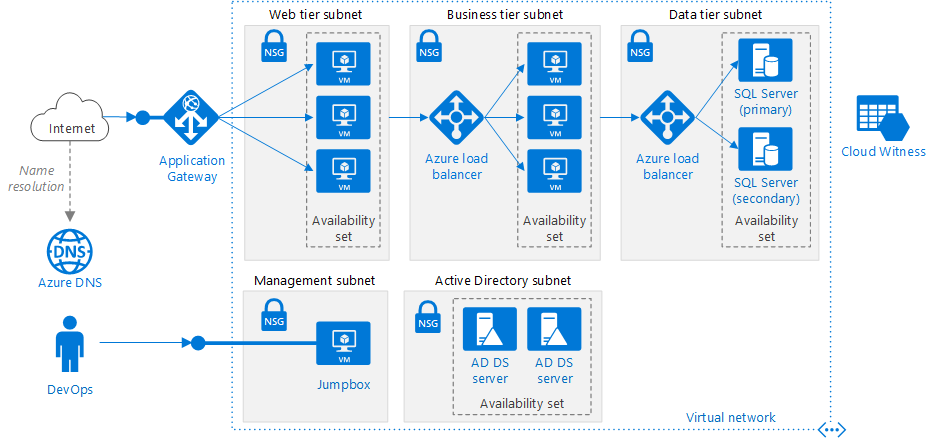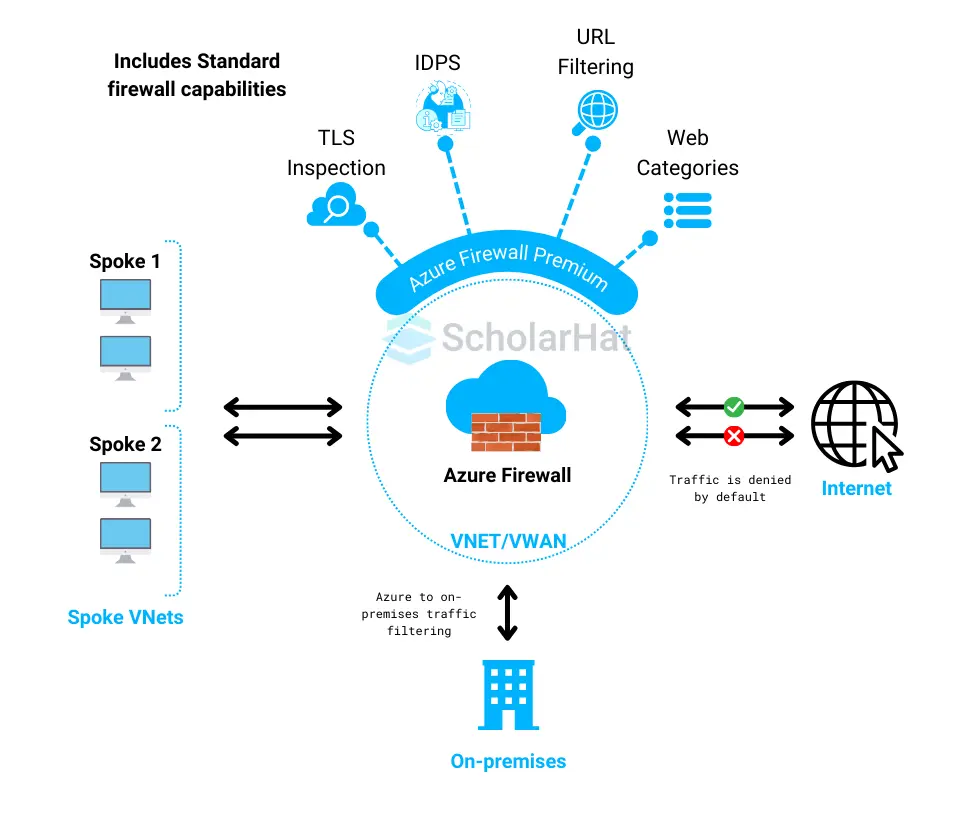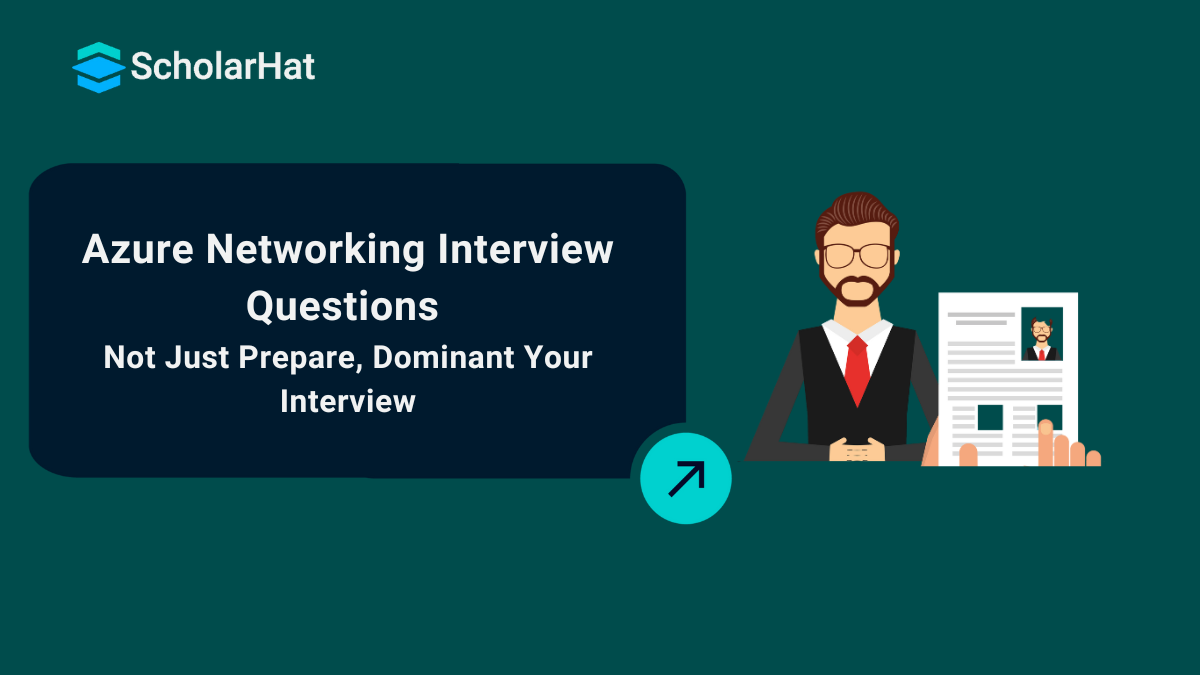18
AprTop 35+ Azure Networking Interview Questions & Expert's Answers
If you're preparing for an Azure interview and still stuck on the important topics, you should cover them before going for your interview. So, Azure Networking is one of them that is the most important topic you should go for. Before jumping into Azure Networking Interview Questions, we should first know about what Azure Networking is.
Azure Networking is a service in Microsoft Azure that helps connect and manage cloud resources securely. It allows virtual machines, databases, and apps to communicate with each other and the internet. It includes features like Azure Virtual Networks, Subnets, Azure Load Balancers, VPNs, and Azure Firewalls to keep data flow smooth and safe.
In the Azure tutorial, Learning Azure Networking and Azure Networking Interview Questions help you understand how cloud networks work, improve security skills, and prepare for cloud-related jobs. The more you know, the better your chances of working with cloud technology and growing your career!
Top 35+ Azure Networking Interview Questions and Answers
Let's explore the most important Azure Networking Interview Questions and Answers.
Q 1. What is Azure Virtual Network (VNet), and why is it important?
Azure Virtual Network (VNet) is a service in Microsoft Azure that allows different resources, like virtual machines (VMs), databases, and applications, to communicate securely with each other. It works just like a traditional network in an office or data center but in the cloud.

Why is it important?
- It connects different Azure services so they can work together.
- It keeps data safe by controlling who can access it.
- It allows secure connections between on-premises networks and Azure.
- It supports private communication without using the Internet.
You can divide a VNet into smaller sections (subnets) to improve security and performance.
Q2. Explain the difference between Azure Load Balancer and Azure Application Gateway.
Azure Load Balancer and Azure Application Gateway are both services that help distribute network traffic, but they have different uses.
| Factor | Azure Load Balancer | Azure Application Gateway |
| Function | Distributes traffic based on IP address and port number. | Routes traffic based on URL, hostname, or HTTP headers. |
| Works At | Network Level (Layer 4 - TCP/UDP) | Application Level (Layer 7 - HTTP/HTTPS) |
| Purpose | Spreads traffic based on IP address and port | Routes web traffic and secures websites |
| Use Cases | Best for general traffic like database servers, VMs, and gaming servers | Best for web applications needing SSL termination and security |
| Security | No security features | Has a built-in Web Application Firewall (WAF) |
| SSL Termination | Does not support SSL termination. | Supports SSL termination, making HTTPS traffic management easier. |
Q 3. What is Azure VPN Gateway, and what are its types?
Azure VPN Gateway is a service that allows secure communication between Azure and on-premises networks using encrypted tunnels. It is mainly used when a company wants to connect its office network to Azure over the Internet.
Types of VPN Gateway
- Point-to-Site (P2S) VPN – Connects a single device (like a laptop) to Azure. Used by remote workers.
- Site-to-Site (S2S) VPN – Connects an entire office network to Azure. Used for company-wide connectivity.
- ExpressRoute – A private, high-speed connection to Azure that does not use the internet. Used for large enterprises.
VPN Gateway is a cost-effective way to connect Azure and on-premises resources securely.
Q 4. What is a Network Security Group (NSG) in Azure?
A Network Security Group (NSG) is a firewall-like service in Azure that controls network traffic to and from resources like Azure Virtual Machines (VMs). It helps protect your network from unauthorized access.
How does Network Security Group (NSG) in Azure work?
- NSGs contain rules that allow or block traffic based on source, destination, port, and protocol.
- Rules are processed in order from the lowest number to the highest.
- If no rule allows the traffic, it is automatically blocked.
By using NSGs, you can increase security and control access to your Azure resources.
Q 5. What is Azure ExpressRoute, and how is it different from VPN Gateway?
Azure ExpressRoute is a service that provides a private, high-speed connection between on-premises networks and Azure. Unlike VPN Gateway, ExpressRoute does not use the public internet, making it faster and more secure.
Differences between VPN Gateway and ExpressRoute
| Factor | Azure ExpressRoute | VPN Gateway |
| Connection Type | Uses the public internet for communication. | Uses a private connection through a telecom provider. |
| Maximum Speed | Maximum speed is 1.25 Gbps. | It can reach speeds up to 100 Gbps. |
| Security | Uses encryption, but data travels over the public internet. | More secure as it does not use the Internet. |
| Reliability | It can have latency and performance issues due to internet traffic. | More stable and reliable because it avoids internet congestion. |
| Best For | Small to medium businesses need a cost-effective connection. | Large enterprises need high-speed, private connectivity. |
Use ExpressRoute for fast, private, and secure connections in large companies.UseVPN Gatewaywhen the cost is a concern and internet-based connections are acceptable.
Q 6. What is an Azure Private Endpoint, and how does it work?
An Azure Private Endpoint is a network interface that allows you to access Azure services securely using a private IP address. It ensures that traffic stays within the Azure Virtual Network (VNet) and does not go through the public internet.
How Azure Private Endpoint Works
- When a Private Endpoint is created, it connects to an Azure service (e.g., Azure Storage, SQL Database).
- The service gets a private IP from the VNet, making it accessible only within that network.
- This eliminates the need for public IPs and enhances security by reducing exposure to the internet.
Q 7. What is Azure Route Table, and why is it used?
An Azure Route Table is a custom routing rule that controls how network traffic flows inside an Azure Virtual Network (VNet).
Why is Azure Route Table used?
- By default, Azure provides system routes, but Route Tables allow custom routing.
- It helps direct traffic to firewalls, VPNs, or specific network appliances.
- It blocks unwanted traffic by defining routes to specific network paths.
Q 8. What is the difference between Public IP and Private IP in Azure?
A Public IP and a Private IP are used to identify network resources, but they serve different purposes.
| Factor | Public IP | Private IP |
| Visibility | Accessible over the internet. | Used inside an Azure Virtual Network (VNet). |
| Security | Exposes services to the public internet, increasing risks. | More secure since it's not internet-facing. |
| Use Cases | Needed for public-facing websites, APIs, and VPN gateways. | Used for internal communication between Azure services. |
| Assigned To | Load Balancers, Virtual Machines (VMs), VPN Gateways. | Virtual Machines, Databases, and Private Endpoints. |
| Costs | Usually charged based on usage. | Free as part of VNet communication. |
Use a Public IP when you need external access and a Private IP when you want secure, internal communication.
Q 9. What is Azure Bastion, and how does it improve security?
Azure Bastion is a managed service that provides secure remote access to Azure Virtual Machines (VMs) without exposing them to the public internet.
How does Azure Bastion improve security?
- No Public IP Needed – You can connect to VMs without assigning public IPs, reducing attack risks.
- Uses Private IP – It connects to VMs through the Azure Portal over a private IP.
- Prevents RDP/SSH Attacks – Protects against brute force and port scanning attacks.
- Built-in Encryption – Ensures secure RDP and SSH connections through the browser.
Azure Bastion is ideal for companies that need secure, browser-based VM access without VPNs or exposing ports to the internet.
Q 10. What is Azure Traffic Manager, and how does it work?
Azure Traffic Manager is a DNS-based load-balancing service that distributes user traffic across multiple Azure regions.
How does Azure Traffic Manager work?
- It routes users to the nearest or best-performing Azure data center based on different routing methods.
- It works at the DNS level, meaning it does not directly control network traffic but redirects requests to the best endpoint.
Routing Methods
- Priority – Routes traffic to a primary server and switches to a backup if it fails.
- Weighted – Distributes traffic based on assigned weights (e.g., 70% to one server, 30% to another).
- Performance – Sends users to the closest Azure region for faster response times.
- Geographic – Routes users based on their geographic location.
Azure Traffic Manager is useful for global applications that need high availability and low latency.
Q 11. What is Azure DDoS Protection, and why is it needed?
Azure DDoS (Distributed Denial-of-Service) Protection is a security service that protects Azure applications from DDoS attacks, where attackers flood a system with excessive traffic to make it unavailable.
Why is Azure DDoS Protection needed?
- Prevents service downtime by filtering out malicious traffic.
- Protects Azure resources like Virtual Machines, Load Balancers, and Web Apps.
- Monitors traffic patterns and automatically blocks suspicious activity.
Q 12. What is Azure Peering, and how is it different from VPN Gateway?
Azure Peering allows direct network connections between two Azure Virtual Networks (VNets). It is different from a VPN Gateway in several ways:
| Features | Azure Peering | VPN Gateway |
| Connection Type | Direct private connection between two VNets. | Secure, encrypted tunnel over the internet. |
| Latency | Very low latency since it is a direct connection. | Higher latency is due to traffic going over the internet. |
| Use Case | Best for connecting Azure VNets in the same or different regions. | Best for connecting on-premises networks to Azure. |
| Security | Uses private IPs, and no encryption is required. | Encrypted connection for secure data transfer. |
| Cost | Lower cost as it avoids internet data transfer fees. | It may have higher costs due to VPN infrastructure. |
Q 13. What is Azure Firewall, and how does it work?
Azure Firewall is a managed, cloud-based firewall service that protects Azure resources from cyber threats.

How Azure Firewall works
- It inspects network traffic and blocks malicious activity.
- It supports application and network-level filtering.
- It can enforce rules for inbound and outbound traffic.
Q 14. What is Azure NAT Gateway?
Azure NAT Gateway (Network Address Translation Gateway) is a service that provides outbound internet connectivity for Azure Virtual Machines in a private subnet.
Why is Azure NAT Gateway helpful?
- It allows private VMs to connect to the internet without a public IP.
- It provides a single static outbound IP, which improves security and tracking.
- It scales automatically to handle large traffic volumes.
NAT Gateway is ideal when you need outbound internet access but want to keep your VMs private.
Q 15. What is Azure Front Door, and how does it differ from Azure Traffic Manager?
Azure Front Door is a global content delivery and application acceleration service, whereas Azure Traffic Manager is a DNS-based routing service.
| Features | Azure Front Door, | Azure Traffic Manager |
| Works At | Application Layer (Layer 7). | DNS Layer. |
| Function | Improves website performance and security. | Routes users to the best Azure region. |
| Load Balancing | Yes, at the application level. | No, only DNS-based redirection. |
| Used For | Fast, secure global web application delivery. | High availability across multiple regions. |
I suggest you use Azure Front Door for faster web performance and Traffic Manager for region-based routing.
Q16. What is a Subnet in Azure, and why do you need it?
A Subnet (short for Subnetwork) is a smaller part of an Azure Virtual Network (VNet). It helps organize and control network traffic by dividing a big network into smaller groups.
Why do you need Subnet in Azure?
- You can group similar resources together.
- It improves security by controlling communication between different parts.
- It helps manage network traffic better.
Q17. What is a Service Endpoint in Azure?
A Service Endpoint allows your Virtual Network (VNet) to connect directly to Azure services like Azure Blob Storage or Azure SQL Database using Microsoft’s backbone network instead of the public internet.
Q18. What is the difference between Azure Private Link and Service Endpoints?
Both allow secure access to Azure services, but they work differently.
| Feature | Azure Private Link | Service Endpoint |
| Connectivity | Uses Private IP from your VNet | Uses Public IP but routes traffic through Azure’s network |
| Security | More secure, completely private | Secures traffic but still uses public IP addresses |
| Access Control | Can restrict access to specific users or services | Can only control access at the VNet level |
| Supported Services | Works with Azure SQL, Storage, Cosmos DB, and more | Supports fewer services compared to Private Link |
| Best For | Highly secure environments like banking or healthcare | General use cases where privacy is not a big concern |
Q19. What is Azure Virtual WAN, and why is it useful?
Azure Virtual WAN (VWAN) is a cloud-based networking service that lets you connect multiple branches, offices, and remote users to Azure easily.
Why is Azure Virtual WAN useful?
- It simplifies network management by handling everything in one place.
- It improves performance and security for companies with multiple locations.
- It supports VPN, ExpressRoute, and SD-WAN connections.
For example, if you own a company with offices in Delhi, Mumbai, and Bangalore, you can use Azure Virtual WAN to connect them securely and smoothly.
Q20. What is a User-Defined Route (UDR) in Azure?
A User-Defined Route (UDR) is a custom rule that you set in a Virtual Network (VNet) to decide how network traffic should flow.
Why do you need it?
- By default, Azure decides the route for your traffic, but with UDR, you get full control.
- You can force traffic through a firewall or a security appliance.
- It helps isolate networks for better security.
For example, imagine you are driving home, and there’s a default route. But if you set up your own GPS (UDR), you can take a different road to avoid traffic or tolls.
Q21. What is the difference between Azure Network Security Group (NSG) and Azure Firewall?
Azure Network Security Group (NSG) and Azure Firewall both protect your Azure network, but they do different things.
| Features | Network Security Group (NSG) | Azure Firewall |
| Function | Controls traffic within a Virtual Network (VNet). | Protects entire network traffic, even from the internet. |
| Layer | Works at Layer 3 & 4 (IP and Port-based). | Works at Layer 7 (Application-based filtering). |
| Stateful? | Yes, remembers connections. | Yes, inspects full traffic. |
| Example | Basic security, like blocking traffic between subnets. | Advanced security, like blocking malware or bad websites. |
| Best For | Allow only certain IP addresses to connect to a VM. | Block access to malicious websites for the entire company. |
Use NSG for basic rules inside a VNet and Azure Firewall when you need stronger protection for your whole network.
Q22. What is the difference between Azure Load Balancer and Azure Front Door?
Both distribute traffic, but Azure Load Balancer works inside a region, while Azure Front Door works globally.
| Factors | Azure Load Balancer | Azure Front Door |
| Scope | Works inside one Azure region. | Works across multiple Azure regions. |
| Protocol | Supports TCP and UDP (Layer 4). | Supports HTTP and HTTPS (Layer 7). |
| Traffic Routing | Routes based on IP and Port. | Routes based on URL, hostname, or HTTP headers. |
| Security Features | No built-in security. | Includes DDoS protection and WAF (Web Application Firewall). |
| Use Case | Balancing traffic between VMs in the same region. | Managing global websites and applications. |
Use Load Balancer for handling traffic inside Azure, and use Front Door when you want to serve customers worldwide.
Q23. What is Azure VNet Peering?
Azure VNet Peering lets you connect two Virtual Networks (VNets) so they can communicate privately without using the public internet.
Why is Azure VNet Peering useful?
- It allows fast and secure communication between different VNets.
- You don’t need a VPN or an ExpressRoute to connect VNets.
- Data moves directly between VNets with low latency and high speed.
Q24. What is an Application Security Group (ASG) in Azure?
An Application Security Group (ASG) helps you group VMs logically and apply Network Security Group (NSG) rules to them.
Why should you use ASG?
- Instead of applying rules VM by VM, you can apply them to a group of VMs.
- It makes security management easier in big networks.
- You don’t need to manage IP addresses manually.
Q 25. What is Azure DNS, and why is it useful?
Azure DNS is a domain name system (DNS) service that helps you manage domain names in Azure instead of using third-party providers.
Why use Azure DNS?
- Faster and more reliable than external DNS services.
- Integrates with Azure for automatic updates.
- More secure because you control everything within your Azure environment.
Q 26. Explore inbound and outbound connections in Azure.
- Inbound Connections: These are the requests coming into your Azure resources from the internet or other networks. For example, when a user accesses your website hosted on an Azure VM, that's an inbound connection.
- Outbound Connections: These are the requests going out from your Azure resources to the internet or other networks. For example, when your Azure VM connects to an external database or API, that’s an outbound connection.
Q 27. What is VPN Gateway in Azure?
Azure VPN Gateway is a service that allows you to securely connect your on-premises network to Azure over the internet. It creates an encrypted tunnel so that your data remains safe while traveling between your office (or another network) and Azure.It is useful when you want to extend your company’s network to Azure or securely connect multiple office locations.
Q 28. Explain about Azure Route Network Traffic.
Azure automatically decides how network traffic moves within a Virtual Network (VNet), but you can control the path using User-Defined Routes (UDR).You can send traffic through a firewall, VPN, or another device instead of using the default Azure route. This is useful for security and better network management.
Q 29. How do you control the flow of traffic to resources connected to your VNet?
To control the flow of traffic to resources connected to your VNet:
- You can control traffic flow using Network Security Groups (NSG), Route Tables, and Azure Firewall.
- NSG helps you allow or block traffic, Route Tables control how data moves, and Azure Firewall protects against threats.
Q 30. What is the Content Delivery Network (CDN)?
Azure Content Delivery Network (CDN) is a service that stores copies of your website’s content in different locations around the world.This helps users load websites faster because they can get data from the nearest CDN server instead of waiting for data from a far-away location.
Q 31. Can the Azure Internal Load Balancer be assigned a public DNS or IP address?
No, an Azure Internal Load Balancer (ILB) is only used inside a Virtual Network (VNet). It is designed for private network traffic and does not have a public IP or DNS.If you need to expose services to the internet, you should use an Azure Public Load Balancer instead.
Q 32. What are the possibilities of having the VM in a different region and having it connect to another region?
If you have a Virtual Machine (VM) in one Azure region and need to connect it to another region, you can use:
- VNet Peering – If both VNets are in different regions, you can use Global VNet Peering.
- VPN Gateway – You can create a secure connection between VNets using a VPN.
- ExpressRoute – If you want a private and high-speed connection, you can use ExpressRoute.
Q 33. Explain the types of Azure VNet Peering.
Azure VNet Peering allows two Virtual Networks (VNets) to communicate with each other. There are two types:
- VNet Peering (Same Region) – Connects two VNets inside the same Azure region.
- Global VNet Peering (Different Regions) – Connects two VNets across different regions.
Both allow fast and secure communication without using the public internet.
Q 34. What are the Network Security Group (NSG) Rules?
Network Security Group (NSG) rules help you control traffic to and from your Virtual Machines (VMs) inside a Virtual Network (VNet).There are two types of rules:
- Inbound Rules – Control traffic coming into your VM.
- Outbound Rules – Control traffic going out from your VM.
Each rule has Priority, Source, Destination, Port, and Action (Allow/Deny) to define how traffic is handled.
Q 35. Explain Azure Micro-Segmentation.
Azure Micro-Segmentation is a way to divide a network into smaller parts so that each part has its own security rules.Instead of setting security for the whole network, you set rules for each Virtual Machine (VM) or application separately. This helps stop hackers from moving to other parts of the network if they get inside.
Q 36. Provide some situations where you can use a Virtual Network (VNet).
You can use Azure Virtual Network (VNet) for many things, like:
- Connecting Virtual Machines (VMs) –This is so they can talk to each other inside the network.
- Connecting to your office network – Using a VPN or ExpressRoute to link your office to Azure.
- Controlling internet access – Using Network Security Groups (NSG) to allow or block traffic.
- Protecting your network – Using firewalls and security rules to keep hackers out.
- Handling lots of users – Using Load Balancers to keep websites and apps running smoothly.
Q 37. What are the types of Azure Load Balancers?
Azure has two types of Load Balancers:
- Public Load Balancer – Distributes traffic from the internet to your Virtual Machines (VMs) in Azure. It is used when you want people outside Azure to access your applications.
- Internal Load Balancer – Works inside your Virtual Network (VNet) and does not have a public IP. It is used for private applications that need load balancing within Azure.
Q 38. Explain the difference between Internal Load Balancers and External Load Balancers.
The difference between Internal Load Balancers and External Load Balancers
| Factors | Internal Load Balancers | External Load Balancers |
| Access Type | Works inside Azure (private network) | Works from the internet (public network) |
| IP Address | Uses private IP | Uses public IP |
| Use Case | For internal apps like databases and VMs | For public-facing websites and apps |
| Traffic Source | Only from inside Azure | From anywhere on the internet |
| Example | Load balancing between backend servers | Distributing user traffic for a public website |
Q 39. Explore the different methods of routing supported by Azure Traffic Manager.
Azure Traffic Manager helps direct users to the best available server. It supports different routing methods:
- Priority Routing – Sends traffic to the primary server first, and if it fails, it moves to the next one.
- Weighted Routing – Sends traffic based on assigned weights (example: 70% to one server, 30% to another).
- Performance Routing – Sends users to the closest or fastest server.
- Geographic Routing – Sends users to a server based on their location (for example, users in India go to the India server).
- Multivalue Routing – Returns multiple healthy endpoints when queried (used for redundancy).
- Subnet Routing – Directs traffic based on the user’s IP address range.
Q 40. What are the different connectivity models that Azure ExpressRoute supports?
Azure ExpressRoute provides private connections between your office or data center and Azure. It supports three connectivity models:
- Cloud Exchange Co-location – Connects through a third-party service provider at a shared data center.
- Point-to-Point Connection – A direct private connection between your office/data center and Azure.
- Any-to-Any (IPVPN) Connection – Uses your existing WAN (Wide Area Network) to connect to Azure.
Why Choose Scholarhat for Azure Certifications?
ScholarHat provides expert-led training for Azure certifications, ensuring you gain in-demand cloud skills for career growth. These certifications validate your expertise in Microsoft Azure, boosting job prospects and industry recognition.
Certifications and Training Courses | Links |
| Azure AI Engineer Certification Training | Click Here |
| Azure Cloud DevOps Engineer Certification Training | Click Here |
| Azure Developer Certification Training | AZ-204 Certification | Click Here |
| Azure AI/ML and GenAI Engineer Certification Training Program | Click Here |
Conclusion
In conclusion, Azure Networking Interview Questions will help you learn how networking works in theAzure cloud. They cover important topics like Virtual Networks, Subnets, VPNs, Load Balancers, and Security Groups, which are useful for managing cloud networks. By practicing Azure Networking Interview Questions, you can understand real-world networking, improve problem-solving, and prepare better for job interviews.
Test your Skills by the following MCQs: Questions and Answers
Test your Azure knowledge with these MCQs to see how ready you are for Azure Networking and boost your confidence!
Q 1: What is an Azure Virtual Network (VNet)?
FAQs
Take our Azure skill challenge to evaluate yourself!

In less than 5 minutes, with our skill challenge, you can identify your knowledge gaps and strengths in a given skill.








